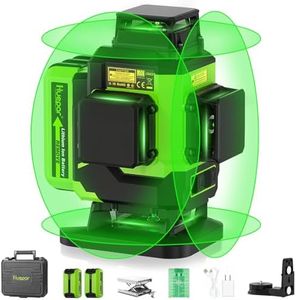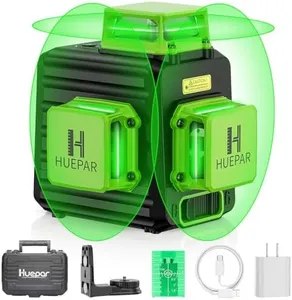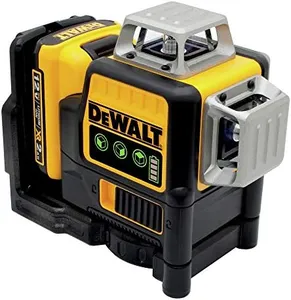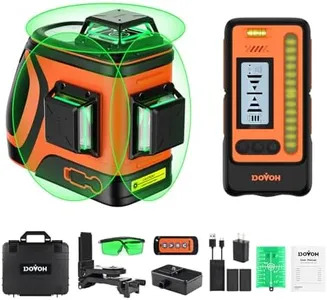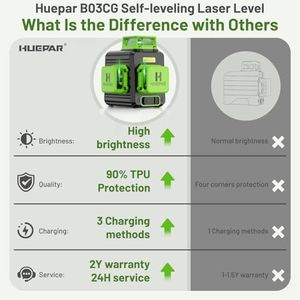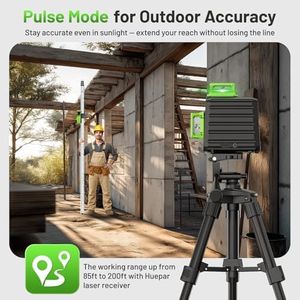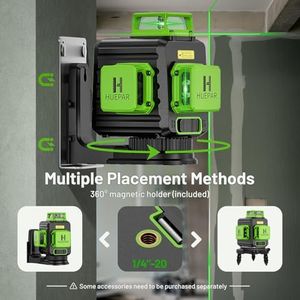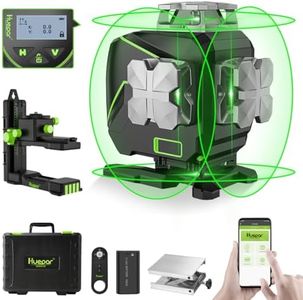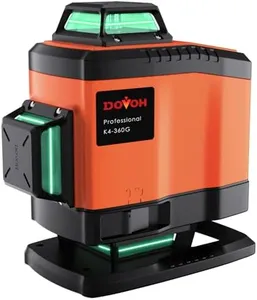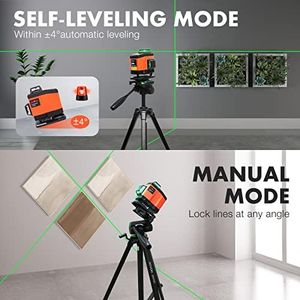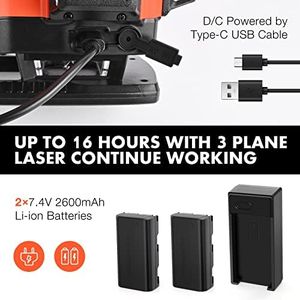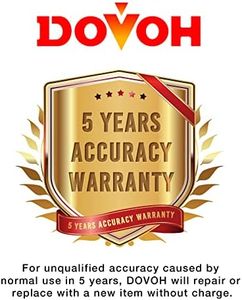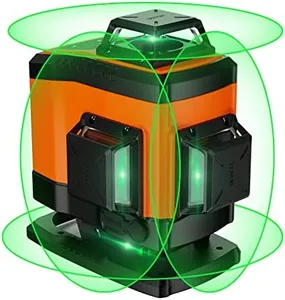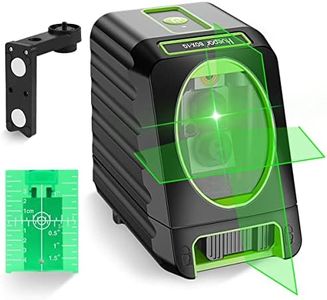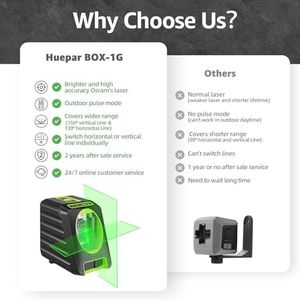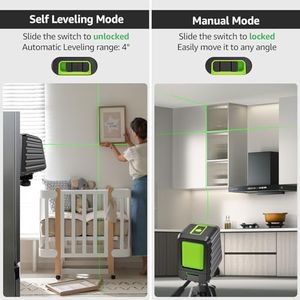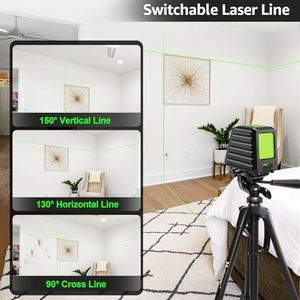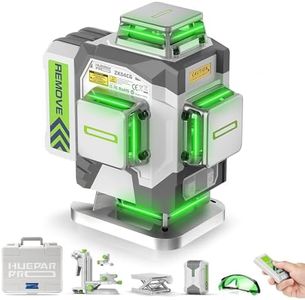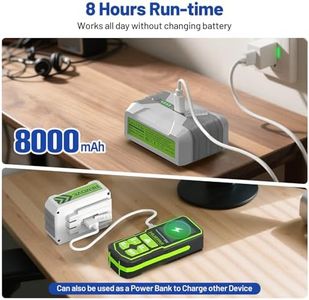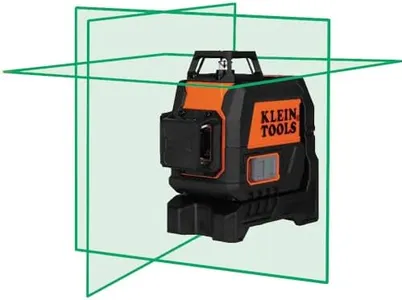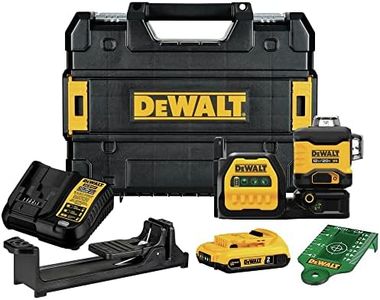10 Best Laser Level For Ceilings 2025 in the United States
Winner
Huepar Laser Level, Self-leveling 16 Lines Green Beam 4D Cross Line Tiling Floor Laser Tool-2 x 360 Horizontal & 2 x 360 Vertical Laser Lines with Two Li-ion Batteries and Hard Carry Case-LS04CG
The Huepar LS04CG laser level is a versatile tool well-suited for ceiling installations and other leveling tasks. It shines with its four full 360-degree laser lines—two horizontal (one designed for ceilings and one for floors) and two vertical that cross at right angles. This wide coverage helps you easily visualize square layouts, which is great for tiling or ceiling work. Its self-leveling feature ensures accuracy by automatically correcting small tilts, while a beep alerts you if it’s outside its leveling range. The green laser beams are brighter and easier to see than red ones, which improves visibility, especially in brighter rooms. Battery life is strong thanks to two large, rechargeable lithium-ion batteries, and the ability to charge them separately via USB-C adds convenience.
Most important from
2120 reviews
Huepar Laser Level 360 Self Leveling, 3 x 360° High Brightness Cross Line Laser for Construction and Picture Hanging, 12 Green Laser Level Tool with 5200 mAh Rechargeable Battery & Hard Carry Case
The Huepar Laser Level 360 Self Leveling is an excellent choice for those looking to tackle construction projects or hang pictures with precise accuracy. One of its standout features is the three-plane laser setup, which allows for comprehensive layout possibilities—one horizontal and two vertical beams. With an accuracy level of ±1/9 inch at 33 feet, it offers reliable performance for various tasks. The high brightness of the green laser is particularly useful in well-lit areas, making it easier to see the lines you’re working with.
Most important from
2060 reviews
DEWALT 12V MAX Laser Level, Green Line Laser, 3-Way, 360 Degree Professional Laser, Cordless/Rechargeable (DW089LG)
The DEWALT 12V MAX Laser Level (DW089LG) is designed for those who need a reliable tool for leveling tasks, particularly when working on ceilings. One of its significant strengths is its green beam technology, which offers high visibility, especially in bright conditions, making it easier to see the laser line compared to traditional red lasers. With an accuracy of +/- 3mm at 10 meters, it provides precision that’s essential for both professional and DIY projects. The self-leveling capability is another plus, ensuring that the laser adjusts itself, saving users time and effort.
Most important from
3851 reviews
Top 10 Best Laser Level For Ceilings 2025 in the United States
Winner
Huepar Laser Level, Self-leveling 16 Lines Green Beam 4D Cross Line Tiling Floor Laser Tool-2 x 360 Horizontal & 2 x 360 Vertical Laser Lines with Two Li-ion Batteries and Hard Carry Case-LS04CG
Huepar Laser Level, Self-leveling 16 Lines Green Beam 4D Cross Line Tiling Floor Laser Tool-2 x 360 Horizontal & 2 x 360 Vertical Laser Lines with Two Li-ion Batteries and Hard Carry Case-LS04CG
Chosen by 1201 this week
Huepar Laser Level 360 Self Leveling, 3 x 360° High Brightness Cross Line Laser for Construction and Picture Hanging, 12 Green Laser Level Tool with 5200 mAh Rechargeable Battery & Hard Carry Case
Huepar Laser Level 360 Self Leveling, 3 x 360° High Brightness Cross Line Laser for Construction and Picture Hanging, 12 Green Laser Level Tool with 5200 mAh Rechargeable Battery & Hard Carry Case
DEWALT 12V MAX Laser Level, Green Line Laser, 3-Way, 360 Degree Professional Laser, Cordless/Rechargeable (DW089LG)
DEWALT 12V MAX Laser Level, Green Line Laser, 3-Way, 360 Degree Professional Laser, Cordless/Rechargeable (DW089LG)
Huepar Laser Level 360 Self Leveling, 4x360° Green 4D Cross Line Laser with LCD Screen, Bluetooth Outdoor Pulse Mode Laser Tool for Construction -Remote Control, Li-ion Battery or 4 AA Batteries-S04CG
Huepar Laser Level 360 Self Leveling, 4x360° Green 4D Cross Line Laser with LCD Screen, Bluetooth Outdoor Pulse Mode Laser Tool for Construction -Remote Control, Li-ion Battery or 4 AA Batteries-S04CG
DOVOH 4x360° Laser Level 360 Self Leveling, 16 Line Laser Leveler for Construction Floor Tiling and Ceiling Rechargeable Green Beam 4D Plane Magnetic Bracket Included, K4-360G
DOVOH 4x360° Laser Level 360 Self Leveling, 16 Line Laser Leveler for Construction Floor Tiling and Ceiling Rechargeable Green Beam 4D Plane Magnetic Bracket Included, K4-360G
Huepar Box-1G Laser Level with Pulse Mode for Indoor & Outdoor Use, 150ft /150° Professional Self Leveling Green Laser Line Tool
Huepar Box-1G Laser Level with Pulse Mode for Indoor & Outdoor Use, 150ft /150° Professional Self Leveling Green Laser Line Tool
HueparPro Laser Level 360 Self Leveling, 4x360°Green Cross Line Laser Tool with Remote Control & 8000mAh Rechargeable Li-ion Battery, High Accuracy 4D Laser for Construction, Magnetic Bracket -ZK04CG
HueparPro Laser Level 360 Self Leveling, 4x360°Green Cross Line Laser Tool with Remote Control & 8000mAh Rechargeable Li-ion Battery, High Accuracy 4D Laser for Construction, Magnetic Bracket -ZK04CG
Klein Tools 93CPLG Compact Self-Leveling Laser Level, Bright Green Cross Line 360-Degree Laser Planes, Rechargeable, Magnetic Mount
Klein Tools 93CPLG Compact Self-Leveling Laser Level, Bright Green Cross Line 360-Degree Laser Planes, Rechargeable, Magnetic Mount
Motovera Laser Level, 100 feet Self Leveling Laser Level, Green Cross Line Rotary Lasers, 4 Brightness Adjustment, Manual Self leveling and Pulse Mode, IP54 Waterproof Battery Carrying Bag Included
Motovera Laser Level, 100 feet Self Leveling Laser Level, Green Cross Line Rotary Lasers, 4 Brightness Adjustment, Manual Self leveling and Pulse Mode, IP54 Waterproof Battery Carrying Bag Included
DEWALT 20V/12V MAX Laser Level Kit, 3 x 360, Green (DCLE34030G)
DEWALT 20V/12V MAX Laser Level Kit, 3 x 360, Green (DCLE34030G)
Our technology thoroughly searches through the online shopping world, reviewing hundreds of sites. We then process and analyze this information, updating in real-time to bring you the latest top-rated products. This way, you always get the best and most current options available.

